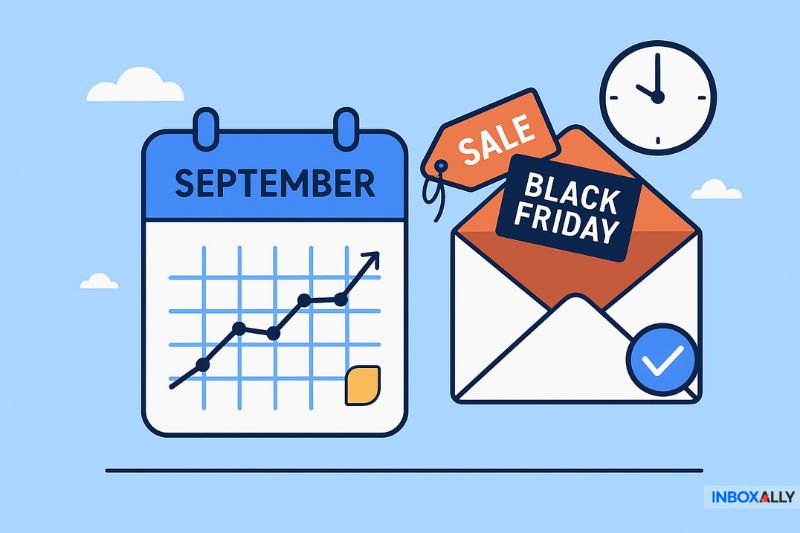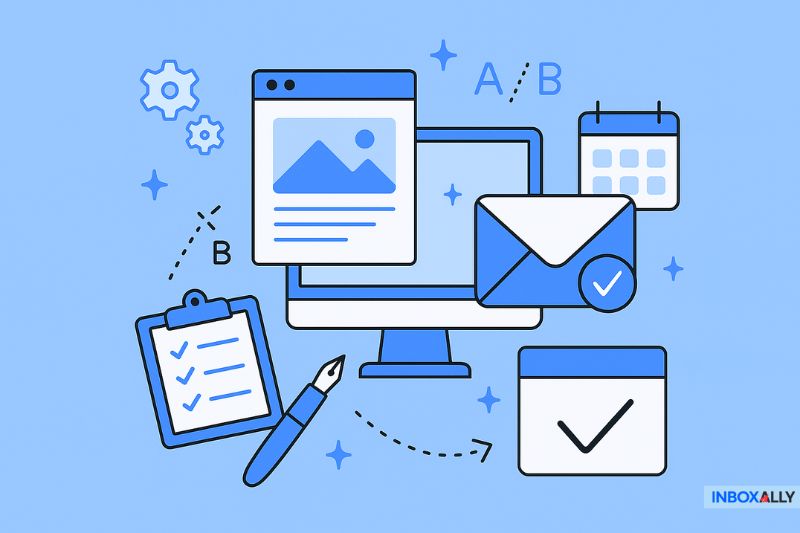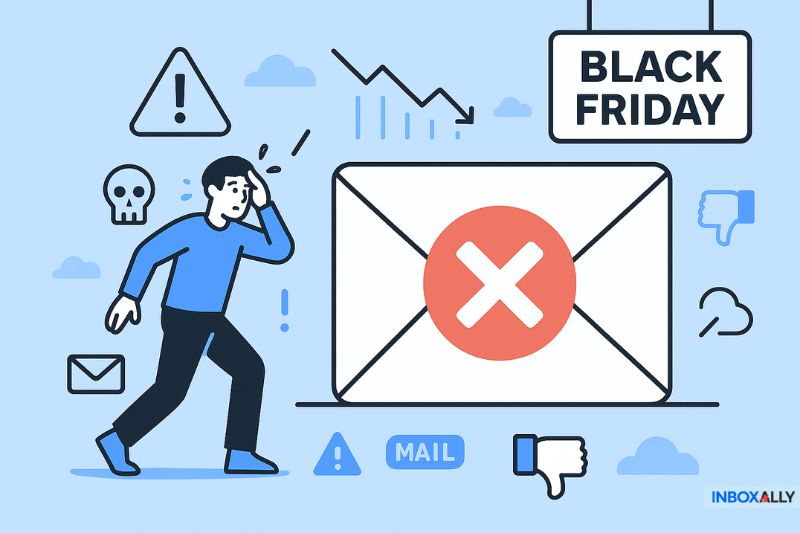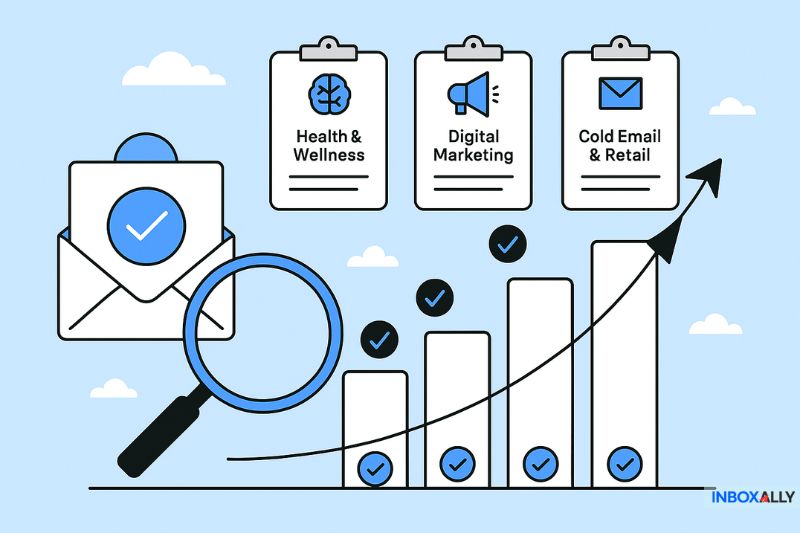For email marketers, Black Friday doesn’t start in November. It starts in September.
By the time the holiday chaos hits, inboxes are already jammed, and spam filtering becomes brutal. Emails end up in promotions, complaints rise, and only senders with a spotless reputation make it through.
The real fight isn’t writing a great promotion. It’s making sure it lands where customers actually see it.
This is why September is the month to get ahead. In this guide, you’ll learn how to secure your reputation before November, the exact checklist to follow now, and the mistakes that can hurt your inbox placement when it matters most. You’ll also see real brand examples of how early prep paid off.
Let’s get started because your holiday inbox placement depends on it.
Why Email Deliverability Is Tougher During the Holiday Season
![]()
Q4 simply is busier. Mailgun’s data put it at 30–40% more volume than any other quarter. That’s billions of extra emails all trying to wedge into the same limited space.
Mailbox providers respond the only way they can: by tightening filters. Rules that might be lenient in the summer become strict, and even small reputation flaws can block your emails from reaching the inbox.
At the same time, recipients are overwhelmed with promotional content.. Think about your own inbox in November: page after page of flash sales, “don’t miss this,” and “last chance.” People open less, unsubscribe more, and the “mark as spam” click becomes second nature. Each of those complaints damages your domain reputation, and the algorithms take notice.
So the challenge isn’t just “more email.” It’s tougher filtering from providers, combined with lower tolerance from subscribers.
That’s why inbox placement gets so competitive during the holidays. There’s only so much room in the Primary tab, and it’s reserved for senders with the cleanest records and the healthiest engagement. Everyone else is out.
Why September Is the Cutoff for Black Friday Prep
It takes 30 to 60 days of steady, healthy sending before mailbox providers start to trust your emails again. That trust is based on patterns: how many of your emails get opened, clicked, replied to, or removed from spam. It’s engagement history that determines where your next campaign lands, not last-minute tricks.
That’s why September is the real deadline. If you wait until October to warm up a domain or re-engage your list, you’ve already run out of runway. Cold domains and inactive lists you’ve ignored now become a problem, and by the time you see deliverability slipping, there’s no chance to turn it around before Black Friday.
Nothing is accidental. All the brands you see in your inbox in November are the ones that started early and have already proven that their emails belong in the inbox.
The September Deliverability Checklist
When Black Friday hits, there’s no room for mistakes. The work you do in September sets the tone for whether your emails land in the inbox or the spam folder.
Use this checklist to prepare.
- Warm up sending domains and IPs – start small, then scale. Gradually ramp up daily volume instead of blasting thousands at once. Sudden spikes are a reputation killer.
- Re-engage inactive subscribers – don’t wait until Black Friday to wake up cold contacts. Send win-back campaigns now, so by November you’re mailing to a list that’s proven responsive.
- Clean and verify lists – Remove bounced addresses, invalid contacts, and spam traps before the holidays. A stale list is the quickest way to ruin inbox placement.
- Segment by engagement – protect your sender reputation by sending to active subscribers only. Highly engaged audiences keep your metric averages steady, which helps with placement.
- Track inbox placement weekly – watch the data as you warm up. If you see inboxing issues, adjust your cadence or content before it snowballs into November.
Run this now, and you’ll have the kind of reputation that mailbox providers reward when the big weekend arrives.
Content & Testing Strategy for Holiday Emails
Once the technical prep is underway, September is also the moment to lock in your email content. Black Friday is no place for experiments. By then, you want subject lines, designs, and send patterns all tested out and ready for launch.
This is the month to rehearse, so why not run A/B tests on subject lines so you know exactly what tone or hook wins attention? Change your send times and track performance, too. Most brands blast on the hour, which is why inboxes clog and filters clamp down. Even small changes in scheduling can make a huge difference.
And don’t forget the creative itself: launch your Black Friday templates, test your CTAs, and refine promo graphics while you still have time to adjust.
Three priorities to focus on:
- Prove what works now – subject lines, designs, timing.
- Fix weak spots early – bad engagement in September will hurt in November.
- Build trust through engagement – skimmable copy, clear CTAs, and personalization.
Because in the end, mailbox providers don’t care about design flourishes; they care about interaction. The more your audience engages, the better your chances of staying out of spam.
By the time Black Friday arrives, everything, down to the last bit, should already be there. That’s the only way to make sure your biggest send of the year brings the strongest results.
Common Mistakes That Ruin Black Friday Deliverability
Every year, brands fall into the same traps, and they’re all avoidable.
- Cold sending in October or November – Starting with a new domain or dusting off an old one right before the holidays is a guaranteed miss. If there’s no history of engagement, providers treat you as unproven, and unproven senders don’t get the benefit of the doubt.
- Over-mailing unengaged contacts – It’s tempting to mail the entire list in November, even the people who haven’t opened in months. But unengaged subscribers are highly unlikely to convert. They’re far more likely to ignore your emails or complain.
- Ignoring the signals in your analytics – Declining opens, low click-through rate, or a sudden increase in spam folder placement are your first indicators that something is wrong. Don’t wait until the biggest week of the year, when it’s too late to course-correct.
- Thinking content alone will save you – Great subject lines and designs won’t save a bad reputation. Deliverability is a two-part system: good content and good engagement history. Neglect one, and the other can’t carry you.
Most mistakes come from waiting too long, sending too wide, or focusing on the wrong things. Avoid making them, and you’ll already be ahead.
Case Studies: Brands That Fixed Deliverability Before a Major Campaign
Let’s now leave the theory behind and see some of these insights in action. Here are four examples of brands and specialists who turned deliverability around just in time for major launches.
Heal Your Nervous System (Health & Wellness)
A mental health brand watched open rates crash from 30% to under 10% and inbox placement sink below 50%. With InboxAlly, they rebuilt trust gradually and got to over 90% inbox placement. Open rates went up to 84%, and program enrollments rose 216% within days.
Agexa Agency (Digital Marketing)
Running campaigns across multiple industries, Agexa saw one client’s deliverability collapse: 5% open rates, 6% inbox placement. Using InboxAlly’s warm-up and engagement training, inbox placement increased to 77% and opens to 41% in just weeks, which restored performance across the board.
B2B Data Provider (Cold Emailing)
Scaling meant 1,000–2,000 cold emails a day. They started at 55% inbox placement. InboxAlly warmed up their domain, and within a month, they were getting 100% inbox delivery with zero spam placement. Proof that cold outreach works if you prep right.
Email Specialist Dara Sklar (Real Estate & Retail)
Managing campaigns for Canadian realtors and retailers, Dara was dealing with spam rates as high as 50%. By introducing InboxAlly into her prep cycle, spam rates dropped to just 2%, and open rates tripled across client accounts.
Different industries, same lesson: when deliverability is treated as infrastructure instead of an afterthought, the change is often dramatic.
How InboxAlly Ensures Holiday Inbox Success
Think about the signals Gmail or Outlook are watching: are people opening? Are they scrolling? Do they ever reply, or move a message out of Spam into Primary? These are tiny behaviors, but together they’re how mailbox providers decide if you deserve to be trusted.
InboxAlly manufactures those signals at scale, so instead of “hoping the filter gods are kind,” you’re actively teaching them to put your campaigns up front.
The catch is that you can’t just trust the process blindly. You need to know if it’s working, so having a dashboard to see it all happen helps big time. InboxAlly shows reputation trends week by week, placement across providers, and even how many messages were rescued.
And it doesn’t demand a rebuild. It runs alongside whatever you already use: Klaviyo, ActiveCampaign, Mailchimp, or even a custom email stack if that’s how you operate. No credential sharing, no migration. You just:
- Pick an engagement profile.
- Set a schedule.
- Let the system run while you focus on campaigns.
Many ecommerce teams and agencies rely on it during Q4. While everyone else is trying to fight their way out of Promotions, they’ve already built a reputation good enough to own the inbox.
Conclusion
If you’re waiting until November, you’ve already lost. Black Friday success isn’t about one subject line or one clever promotion; it’s more about the work you do before everyone else.
If you want to win the race, you should be warming your domains, re-engaging your lists, and tracking inbox placement right now. Everyone who heads into Q4 with mailbox providers on their side can expect great outcomes.
So here’s what you can do:
Do it now, not later. Because when the biggest weekend of the year hits, you won’t have the luxury of a second chance.





